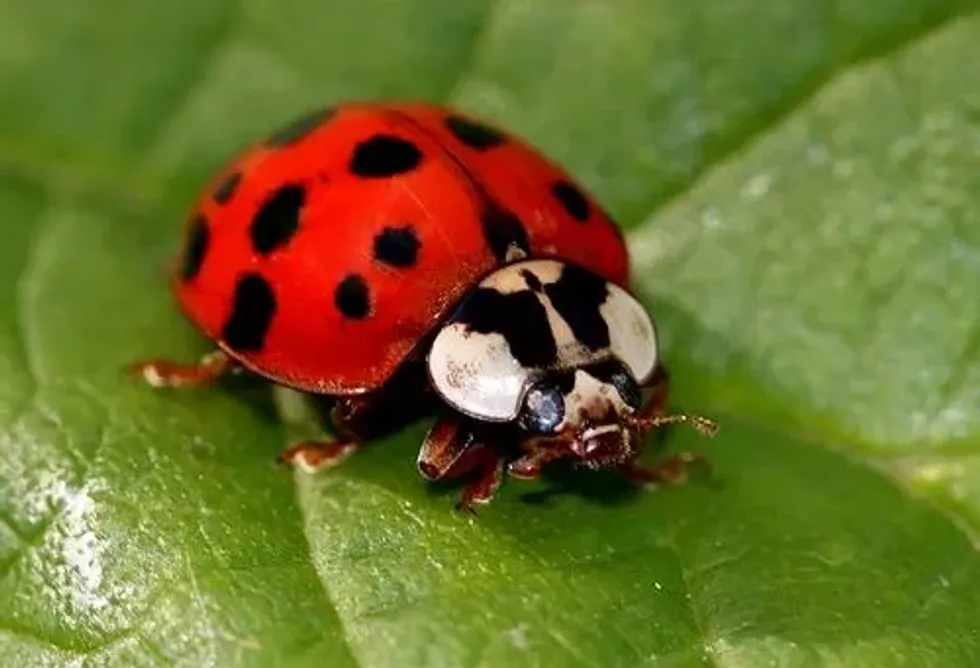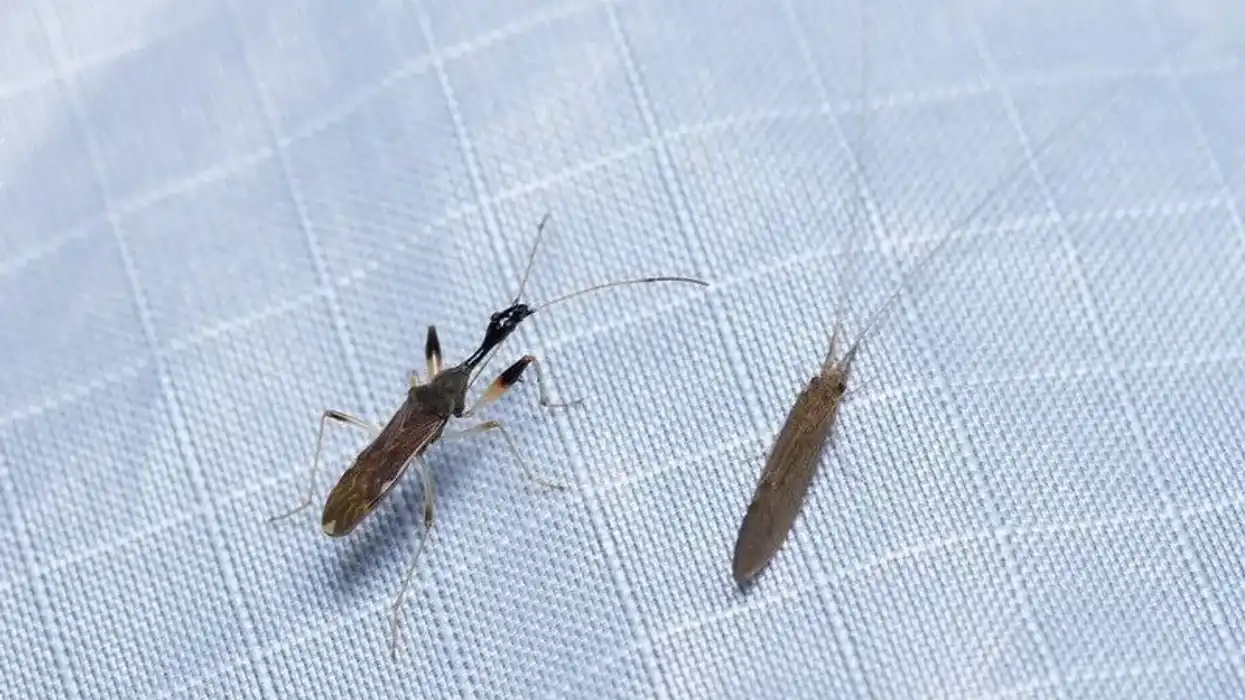The Asian lady beetle (Harmonia axyridis) belongs to the Coccinellidae family. They originated in East Asia and were introduced to countries of North America and Europe. The species vary in color and are hence commonly referred to as multicolored Asian lady beetles (Harmonia axyridis).
They are found in meadows and open fields. They are considered to be beneficial insects as they eat pests that damage crops.
Thus, they control the growth of pests in agricultural fields. Their life cycle undergoes four stages, namely eggs, larvae, pupae, and adults. These lady beetles have an average lifespan of 30 to 90 days.
Their breeding season usually occurs at the beginning of spring. They secrete pheromones to attract mates on the breeding ground. Fertilization is internal, and after mating, females lay around 20 to 30 eggs. The eggs are usually yellow in color and hatch after three days.
The larvae undergo five developmental stages or instars. They often feed on unhatched eggs. The conservation status of the Asian lady beetle has been marked as Not Evaluated by the Internation Union for Conservation of Nature or IUCN Red List.
If you liked reading this article, then do check out the ladybird and the bombardier beetle.
Asian Lady Beetle Interesting Facts
What type of animal is an Asian Lady Beetle?
The Asian lady beetle is an insect that belongs to the Coccinellidae family. It is an indigenous species of eastern Asia and is found in parts of Europe and North America. It is also known as the harlequin, Halloween lady beetle, multicolored Asian lady beetle, multivariate ladybird, pumpkin ladybird, and Japanese ladybird.
What class of animal does an Asian Lady Beetle belong to?
Asian lady beetles belong to the class Insecta. The scientific name of this species is Harmonia axyridis. Peter Simon Pallas was the one who gave these lady beetles their scientific name.
How many Asian Lady Beetles are there in the world?
The exact number of this species of lady beetle is not known. They are found in large numbers in various East Asian countries.
Where does an Asian Lady Beetle live?
Multicolored Asian lady beetles are native to the Eastern part of Asia. Their range extends from Siberia in the north to Yunan and Guangxi Provinces, located in China, to the south.
In the west, they inhabit Kazakhstan, Uzbekistan, and Central Siberia. They are found on the Pacific coast and in Japan in the east.
These lady beetles also live in Taiwan, Mongolia, and North and South Korea. Many species of lady beetles have been artificially introduced to various parts of North America and Europe to control pests. In Europe, they reside in the United Kingdom, Denmark, Norway, Italy, Spain, Sweden, France, Belgium, Germany, Poland, Slovakia, Hungary, Serbia, Croatia, Bosnia, and Herzegovina.
In North America, the lady beetles mostly occupy regions in Canada, Mexico, and the United States. They are also found in Panama, Guatemala, Honduras, and Costa Rica in Central America.
Lady beetles inhabit countries like Argentina, Brazil, Ecuador, Chile, Colombia, Peru, and Venezuela in South America. They are also found in countries like Israel and South Africa.
What is an Asian Lady Beetle's habitat?
Asian lady beetles prefer open habitats where there is plenty of sunlight. These terrestrial insects reside in savanna grasslands. This habitat comprises trees that are widely spaced from each other. These areas also comprise a herbaceous layer on the ground.
They are also found in scrub forests comprised of deciduous trees. They mostly inhabit meadows and open agricultural fields. Meadows are areas that comprise shrubs, grasses, herbs, or other non-woody plants.
Who do Asian Lady Beetles live with?
Asian lady beetles are usually found in large numbers forming groups or clusters. A group of lady beetles is commonly known as loveliness.
How long does an Asian Lady Beetles live?
Asian lady beetles have a lifespan of 30 to 90 days in the wild. However, some of the species have lived up to three years.
How do they reproduce?
Asian lady beetles are promiscuous, having more than one partner throughout their lives. The breeding season usually occurs at the beginning of spring. The optimal temperature for breeding is above 50 F (12 C).
Adult beetles secrete pheromones to attract mates on the breeding ground. Female beetles often select mates based on the color of their forewings.
Certain colors present in the wing covers or elytra help in hiding or escaping from predators. Fertilization is usually internal, and after mating, females usually lay around 20 to 30 eggs. They usually lay eggs in clusters on the underside of leaves.
The eggs are yellow in color and hatch after three days. Parental care towards the larvae is not observed in these species.
However, females often lay a few unfertilized eggs, which act as a food source for the Asian lady beetle larva. The larvae undergo five developmental stages or instars. Their entire life cycle contains four stages, namely eggs, larvae, pupae, and adults.
What is their conservation status?
The conservation status of the Asian lady beetle has been marked as Not Evaluated by the International Union for Conservation of Nature or the IUCN Red List. The destruction of habitat and climate change are some of the threats encountered by these species.
Asian Lady Beetle Fun Facts
What do Asian Lady Beetles look like?

Asian lady beetles vary in their coloration from one species to another. Hence they are also called multicolored Asian lady beetles. Mostly they have red or orange bodies with distinct black spots.
There can be as many as 19 to 22 black spots present all over the body of lady beetles. Some species have orange spots instead of black. The pronotum present behind the head has a white area with black spots.
This black spot forms an M-shaped structure which helps in their identification. These lady beetles are usually darker in color in their native countries, while lighter shades are observed in other areas.
They also have square-shaped shoulders. The larvae are usually black, with two distinct orange lines on the dorsal area. They have a body length of 0.2-0.4 in (7.5 to 10.7 mm).
The adult male and female Asian lady beetles have a slightly variable ventral segment in their abdominal region. Their legs are usually reddish-brown. The pattern of their wing covers, or elytra, also varies.
How cute are they?
Their cuteness usually stems from their appearance. The presence of red or orange bodies, black spots, patterns of their wing covers along with white and black markings behind the head, and reddish-brown legs adds to their cuteness and makes them attractive.
How do they communicate?
Asian lady beetles usually communicate through sensory signals. They secrete various pheromones to communicate with other species. During the breeding season, they release pheromones to attract mates.
These chemicals also help to detect other members during hibernation. A particular pheromone, known as Harmonine, is released when they are threatened. They also have good vision along with olfactory sensation, which helps them in hunting for prey.
How big is an Asian Lady Beetle?
The size of Asian lady beetles ranges from 0.2-0.3 in (5-8 mm). They are smaller than the ground beetle (1.5 in), belonging to the Carabidae family, which is almost five times their size.
How fast can Asian Lady Beetles move?
Asian lady beetles are known to attain a speed of 37 mph (59.5 kph) while traveling along the ground.
How much does an Asian Lady Beetle weigh?
An Asian lady beetle (Harmonia axyridis) weighs around 0.07 oz (2 g).
What are the male and female names of the species?
Scientists do not have specific names to refer to the male and female Asian lady beetles. They are commonly referred to as male Asian lady beetles and female Asian lady beetles.
What would you call a baby Asian Lady Beetle?
Baby Asian lady beetles are commonly referred to as larvae.
What do they eat?
Multicolored Asian lady beetles are omnivorous and feed on a variety of insects and pests, along with fruit and pollen. They feed on a significant number of pests found in the agricultural field, namely aphids and scale insects. Hence they are regarded as beneficial insects as they help to control pests like aphids.
They also eat spider mites, moth's eggs, ladybugs, butterflies, and various soft-bodied insects. They are known to feed on other species of their own family. They eat shrubs, herbs, grapes, and other juicy fruits.
Are they harmful?
Yes, Asian lady beetles are considered to be harmful. They often grow uncontrollably on agricultural fields and damage crops. They are known to cause a lot of damage to the grape industry and other native species. They use a mechanism known as reflex bleeding, where they eject a toxic chemical into fruits and other crops.
This toxin causes staining and has a bad odor. They are also known to bite humans if provoked. Their bites can be dangerous, forming blisters on the skin and other allergic reactions.
Would they make a good pet?
Yes, Asian lady beetles can make good pets. These small insects do not take up much space and control the growth of unwanted pests like aphids on crops.
However, their population can become unmanageable and difficult to control. Lady beetles form clusters on windows and doors and damage crops. Some individuals are known to be allergic to these insects, and their bites can be dangerous.
Did you know...
Asian lady beetles were named after the farmers who worked in the agricultural fields back in the middle ages. The crops present in the fields were infested by aphids. The farmers sought help through prayers from the Virgin Mary.
Following this, the lady beetles appeared and ate the aphids. Thus, the crops were saved from damage. The farmers regarded these insects as 'Our Lady's beetles', and hence, their origin can be traced back to the middle ages.
They hibernate during the winter months for about nine months. The species living in colder regions usually go into a period of hibernation instead of migrating to warmer regions. During this time, they thrive on the fat stored inside their body.
Getting rid of Asian Lady Beetles
Asian lady beetles are introduced to agricultural fields or gardens to control the growth of pests like aphids, but they often cluster in large numbers in houses. Firstly, windows, doors, or other openings should be closed to prevent their entry. They can be removed with vacuum cleaners.
Sweeping should be avoided as it can trigger their reflex bleeding mechanism. This can create stains on light-colored surfaces.
It is recommended to use gloves while handling them as they can bite. Insecticides can also be sprayed on them. It should be sprayed repeatedly on the places they had previously infested to prevent their re-entry.
Why are Asian Lady Beetles bad?
These insects cause serious damage to crops and form clusters inside the household. They contain a pheromone known as Harmonine, which is released as a form of defense to escape predators. They also carry a chemical called isopropyl methoxy pyrazine. This is released when they are threatened. Lady beetles are also known to bite humans and cause allergic reactions.
Here at Kidadl, we have carefully created lots of interesting family-friendly animal facts for everyone to discover! Learn more about some other arthropods including the ambush bug and the ten-lined June beetle.
You can even occupy yourself at home by drawing one of our Asian lady beetle coloring pages.










